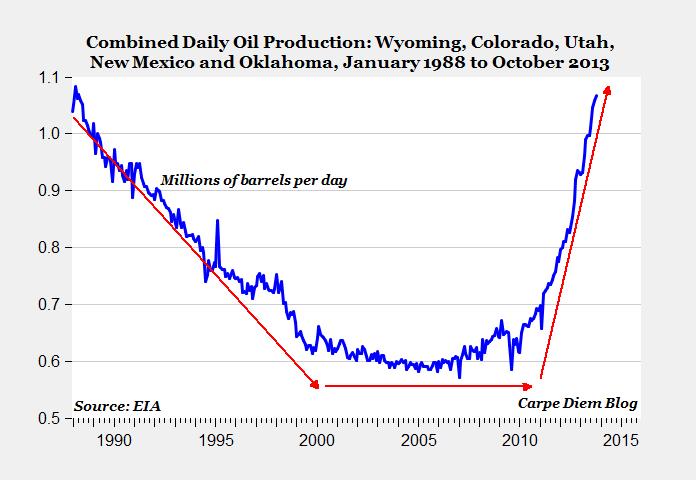Okay, I’m using a very loose definition of field. But check out the following graph of combined oil production from those five states. We’re talking production level of super-giant fields.
Graph is from Carpe Diem, Shale prosperity spreads to Wyoming, Colorado, Oklahoma, Utah, N. Mexico: Combined oil production up 56% in 3 years. Graph is used with permission of Carpe Diem.
Prof. Mark Perry calculates combined production increased 56% in those five states in the three years from October 2010 (0.68M bopd – M = millions, bopd – barrels of oil per day) to October 2013 (1.07M bopd).
From eyeballing the graph, production dropped by about half from 1988 to 2001 – going from just under 1.1M bopd to about 0.6M bopd. That’s around a 45% drop over a roughly 13 year span.
Production then remained in the 0.6M bopd range from 2002 through 2007 when production starting rising,
Eyeballing the production for ’08 and ’09 gives me an estimated average of under 0.65M, perhaps 0.63M bopd. Then the rapid increase starts, hitting around 1.07M bopd in very late ’13.
That’s something in the range of a 78% increase from the floor and somewhere around 70% runup since the higher production in ’08 and ’09.
Amazing.
Super-giant fields
The cutoff for super-giant fields seems to be one million bopd. When Bakken crosses that threshold soon, there will be ten fields that have ever reached that production level. I discussed the super-giants earlier.
I’m stretching the definition of “field” way past the breaking point, but I’ll do it anyway for comparison purposes….If the production of Wyoming-Colorado-Oklahoma-Utah-New-Mexico was actually one field, it would have entered the elite class of super-giant fields in early ’13.
Even without that stretched definition, combined production from those states passed production from the North Dakota portion of the Bakken field in 2013.
I’ll add the Wyoming-Colorado-Oklahoma-Utah-New-Mexico “field” to the big shale plays I try to keep an eye on.
Cause and result
The cause of that huge run up in production?
Human ingenuity visible in discovering and applying 1) horizontal drilling, 2) with hydraulic fracturing, 3) done in multistage fracks, 4) using the right mix of oil, sand, and a few chemicals.
The result?
Lots of royalty payments to landowners, lots of severance tax income to governments, lots of employment, lots of gross revenue & bottom line for E&P companies, increased wealth spread around 5 states, and lots of energy for anyone who enjoys using petroleum products.
Oh. By the way….
….as Professor Perry likes to say: What Peak Oil?
